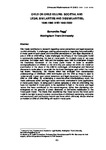Child on Child Killing: Societal and Legal Similarities and Dissimiliarities 1840-1890 and 1950-2000
| dc.contributor.author | Pegg, Samantha | |
| dc.date.accessioned | 2017-03-14T15:09:54Z | |
| dc.date.accessioned | 2017-04-10T15:45:44Z | |
| dc.date.available | 2017-03-14T15:09:54Z | |
| dc.date.available | 2017-04-10T15:45:44Z | |
| dc.date.issued | 2007-11 | |
| dc.identifier.citation |
Pegg, S. (2007) 'Child on Child Killing: Societal and Legal Similarities and Dissimiliarities 1840-1890 and 1950-2000', Crimes and Misdemeanours: Deviance and the Law in Historical Perspective, 1(2), pp.175-202. Available at: https://pearl.plymouth.ac.uk/handle/10026.1/8828 | en_US |
| dc.identifier.issn | 1754-0445 | |
| dc.identifier.uri | http://hdl.handle.net/10026.1/8828 | |
| dc.description.abstract |
This thesis contributes to research regarding social perceptions and legal responses to child criminality. It challenges existing preconceptions regarding the predictability of moral panic in such cases and the social perceptions of, and legal responses to, acts of child on child killing. It also challenges the efficacy of the moral panic model in successfully explicating the rise of moral panic. An in-depth study of two case examples, the Bulger case 1993 and the Burgess case 1861 is undertaken through the theoretical framework of the moral panic model. In order to establish conceptualisations of children at the time they are subsumed within the model an examination of the place of the child in socio-legal, criminological and historical discourse is undertaken to ascertain the dominant ideologies upon which the model has drawn. Resultantly, the rhetoric which has emerged from contemporary understandings of childhood, child victimisation and the child as threat is seen to fundamentally impact upon social receptions and legal responses to incidences of child on child killing. By undertaking a cross-historical interdisciplinary study this thesis addresses social and legal facets commonly overlooked in strict applications of moral panic theory. In doing such it allows episodes of child on child killing that have not resulted in moral panic to be explained in light of the social and legal factors that have contributed to this non-emergence, rather than dismissing nonemergence on the grounds of press disinterest or ineffective mobilisation of the moral panic model. The thesis then establishes that those factors the moral panic model is too rigid to accommodate: constructions of childhood, sentencing rationales and excusatory and justificatory rhetoric are those which ultimately dictate whether an incident of child on child killing will result in moral panic. | en_US |
| dc.language.iso | en | en_US |
| dc.publisher | University of Plymouth | |
| dc.rights | Attribution 4.0 International (CC BY 4.0) | * |
| dc.rights.uri | https://creativecommons.org/licenses/by/4.0/ | * |
| dc.title | Child on Child Killing: Societal and Legal Similarities and Dissimiliarities 1840-1890 and 1950-2000 | en_US |
| dc.type | Article | en_US |
| dc.type | Article | |
| plymouth.issue | 2 | |
| plymouth.volume | 1 | |
| plymouth.journal | SOLON Crimes and Misdemeanours |



